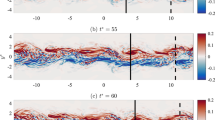Abstract
The proper orthogonal decomposition (POD) method was applied to analyzing the database obtained from the direct numerical simulation (DNS) of supersonic plane mixing layers. The effect of different forms of the inner products in the POD method was investigated. It was observed that the mean flow contributes to a predominant part of the total flow energy, and the energy spectrum of the turbulence fluctuations covers a wide range of POD modes. The patterns of leading (high energy) POD modes reveal that the flow structures exhibit spanwise counter rotating rolls, as well as oblique vortices. These flow patterns are insensitive to the velocity of the observer. As the convective Mach number increases, the energy spectrum becomes wider, the leading POD modes contain more complicated structures, and the flow becomes more chaotic.
Similar content being viewed by others
References
Lumley J L. The structure of inhomogeneous turbulence. In: Yaglom A M, Tatarski V I, eds. Atmospheric Turbulence and Wave Propagation. Moscow: Nauka, 1967. 166–178
Aubry N, Holmes P, Lumley J L, Stone E. The dynamics of coherent structures in the wall region of a turbulent boundary layer. J Flu Mech, 1988, 192: 115–173
Ma X, Karniadakis G. A low-dimensional model for simulating three-dimensional cylinder flow. J Flu Mech, 2002, 458: 181–190
Moehlis J, Smith T R, Holmes P, Faisst H. Models for turbulent plane Couette flow using the proper orthogonal decomposition. Phys Flu, 2002, 14(7): 2493–2507
He J, Fu S. POD analysis of large-scale coherent structures in turbulent thermal convection. Acta Mech Sin (in Chinese), 2003, 35(4): 385–392
Patte-Rouland B, Lalizel G, Moreau J, Rouland E. Flow analysis of an annular jet by particle image velocimetry and proper orthogonal decomposition. Meas Sci Tech, 2001, 12(9): 1404–1412
Mereno D, Krothapalli A, Alkislar M B, Lourenco L M. Low-dimensional model of a supersonic rectangular jet. Phys Rev E, 2004, 69: 026304
Lumley J L, Poje A. Low-dimensional models for flows with density fluctuations. Phys Flu, 1997, 9(7): 2023–2031
Rowley C W, Colonius T, Murray R M. Model reduction for compressible flows using POD and Galerkin projection. Phys D, 2004, 189: 115–129
Brown G L, Roshko A. On density effects and large structure in turbulent mixing layers. J Flu Mech, 1974, 64: 775–816
Clemens N T, Mungal M G. Large-scale structures and entrainment in the supersonic mixing layer. J Flu Mech, 1995, 284: 171–216
Leep L J, Dutton J C, Burr R F. Three dimensional simulations of compressible mixing layers: Visualizations and statistical analysis. AIAA J, 1993, 31: 2039–2046
Day M J, Reynolds W C, Mansour N N. The structure of the compressible reacting mixing layer: Insights from linear stability analysis. Phys Flu, 1998, 10: 993–1007
Li Q. Numerical study of compressible mixing layer with BGK scheme. Dissertation for the Doctoral Degree. Beijing: Tsinghua University, 2002
Fu S, Li Q B. Numerical simulation of compressible mixing layers. Inter J Heat and Fluid Flow, 2006, 03: 028
Holmes P J, Berkooz G, Lumley J L. Turbulence, Coherent Structures, Dynamical Systems and Symmetry. Cambridge: Cambridge University Press, 1996
Sirovich L. Turbulent and the dynamics of coherent structures. Parts I–III Quarterly of Appl Math, 1987, XLV(3): 561–582
Kostas J, Soria J, Chong M S. A comparison between snapshot POD analysis of PIV velocity and vorticity data. Exp Flu, 2005, 38: 146–160
Author information
Authors and Affiliations
Corresponding author
Additional information
Supported by the National Natural Science Foundation of China (Grant No. 10232020, 90505005)
Rights and permissions
About this article
Cite this article
Yang, Q., Fu, S. Analysis of flow structures in supersonic plane mixing layers using the POD method. Sci. China Ser. G-Phys. Mech. As 51, 541–558 (2008). https://doi.org/10.1007/s11433-008-0029-2
Received:
Accepted:
Published:
Issue Date:
DOI: https://doi.org/10.1007/s11433-008-0029-2




